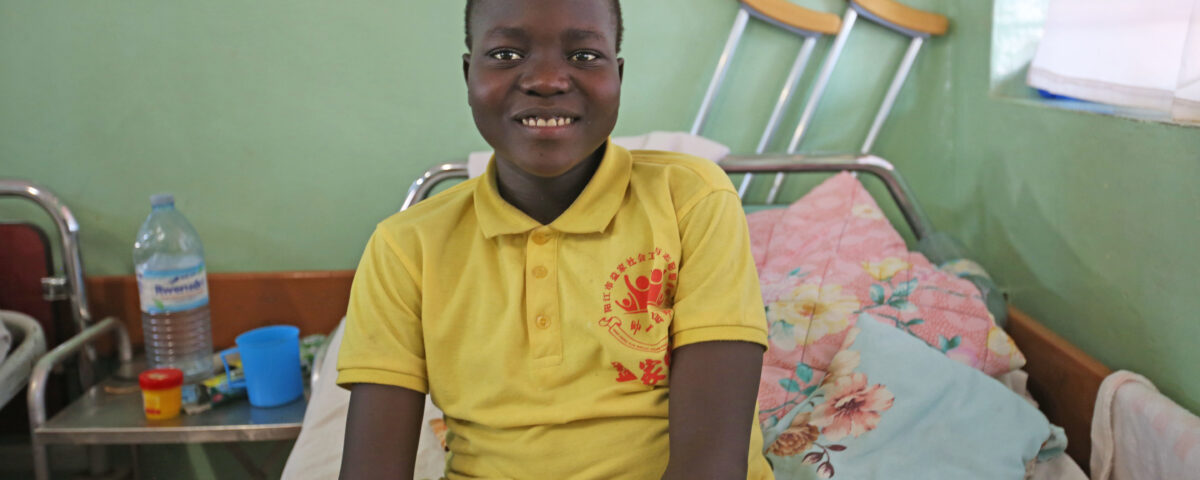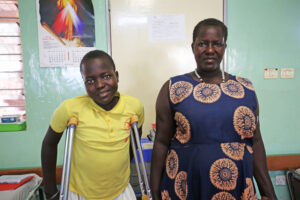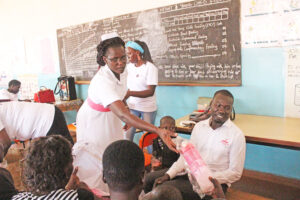For most children, a fall during play, a scraped knee, or even a broken bone is just part of growing up. With some care, comfort, and time, they bounce back—stronger, braver, and ready to run again. But for children living with sickle cell disease, the story often takes a different turn. What seems like a small injury can unfold into something much more serious; the pain runs deeper, the healing takes longer, and the risks are far greater.
This was the reality for 16-year-old Oketayot Bosco from Apaa in Amuru, whose life was simple and joyful. He was always running around with his siblings, laughing, playing, and rolling tires with his older sister. For years, one of their favorite games was tire racing and jumping over it. It was all innocent fun until one fateful day in 2022 when a jump went wrong.
Bosco tripped and fell hard on his hip.
And that single fall would change and reshape not only his health but also his entire young life.
“We were in the garden, just nearby, when his screams cut through the air,” his mother recalled. “We rushed and found him lying there, unable to move. We had to carry him to Lacor Amuru Health Center III.” She said.
From there, the medical team quickly realized that Okatayot’s condition required urgency and specialized care and immediately referred him to Lacor Hospital Main Complex in Gulu.
Upon arrival, a scan was performed, and the result revealed that Bosco had sustained a bent bone. He was admitted to the surgical ward and placed in what is called a Splint Traction—a medical device used to immobilize and align broken or deformed bones, especially in the leg, using weights and pulleys. For three long weeks, his leg hung in the traction device.
After that, doctors reviewed and recommended a plaster be cast (P.O.P.), and when things seemed to have improved, the cast was eventually removed, and Bosco was discharged.
Life picked up again. Bosco returned to school and stayed with a school nurse while continuing with Primary Four, the class he missed for two terms. However, in June of the following year, 2024, things took a turn once more.
The nurse noticed something alarming in Bosco’s movement. He was limping, and his eyes had turned yellow. Without hesitation, he called Bosco’s mother, and she rushed to the school to find her son pale, weak, and in visible pain.
To her, it was unmistakable; this wasn’t just an injury; it was sickle cell disease. A condition that Bosco had lived with since birth. And the yellowing of the eyes? That often signaled danger of severe anemia, and God knows she wasn’t taking another hour in any health center.” The nurse told me to go to a nearby clinic called Mugula, but deep down I knew I wasn’t going to waste any more time or money there.” She said
That is when she got Bosco on a boda and headed straight to Lacor Hospital yet again after a year. Soon, they were at our Emergency unit, and quickly they hurried with him for a scan.
When the scan results came back, they showed something serious—there was pus around the swollen part of Bosco’s thigh, and that meant infection.
To treat it, he had to undergo surgery. It was the first time Bosco was going to be cut open. His skin was already weak from years of battling sickle cell disease, and now, it had to face something new. On the 7th, doctors operated and removed the pus. The wound was cleaned and dressed. Things were starting to look better. Everyone thought Bosco was finally going home. But just when hope was near, another blow came—his thigh bone broke again.
This time, it wasn’t from falling or an accident. It was a pathological fracture, which happens when a bone breaks because it has become too weak from disease or infection, according to Dr. Samuel. In Bosco’s case, his bone had gone through too much. The sickness and the infection had quietly eaten away at its strength, and it simply snapped.
“It’s like the world keeps hitting him when he’s trying to stand,” his mother, Aciro Hellen, said quietly. “His sisters are home with their father, the crops are dying, and there’s no money. But we’re here, and we’ll stay until Bosco heals.”
Bosco was taken back to the theatre. This time, to fix a metal implant to hold his broken bone together. And while still healing, another tragedy struck. In July, the same month Bosco had the implant surgery, his father, his family’s only support back home, fell seriously ill. Two months later, in September, he died in the medical ward of the same hospital. Aciro, torn between her sick son and her dying husband, had to leave Bosco for one day to bury him.
She returned, and they stayed another three months in the hospital. When Bosco seemed a little better, Aciro asked for a short discharge to check on her other children. But once home, things didn’t go well. The wound got infected again. It became clear that the care he needed wasn’t possible outside the hospital. When they returned, doctors found the bone wasn’t healing, and the infection was worse.
We spoke to Dr. Odong Samuel Remmy, the orthopedic officer treating Bosco. He explained why Bosco’s bone was taking so long to heal. “First,” he said, “his sickle cell disease stops blood from flowing properly. His bones don’t get enough oxygen, which slows healing; it is like trying to fix something without the tools or energy to do it. Second, he got an infection deep in the bone marrow caused by bacteria. That infection keeps damaging the bone, making healing even harder.”
This time, doctors removed the implant and fixed an external device to hold the bone steady. With better care to prevent infection, his wounds are finally healing, and we hope for the best.
When the scan results came back, they revealed something deeply troubling—pus had collected around the swollen area of Bosco’s already affected thigh, and surgery was no longer an option; it was a necessity. For the first time in his life, Bosco—already fragile from battling sickle cell disease had to undergo an operation.
On the 7th June, the surgery went well and the pus was removed, the wound cleaned, and he began to show signs of recovery. Discharge was finally in sight. But just as hope began to flicker, it was snuffed out. Bosco sustained what doctors called a pathological fracture—a break in the bone not caused by injury or trauma, but by the bone being weakened from disease. In Bosco’s case, his thigh bone—already compromised by sickle cell complications and infection—simply gave way under pressure. It was as if the world had gone blind to his suffering, serving him yet another challenge just when he was about to stand again.
His mother, Aciro Hellen, stood helpless. “Situations don’t know poverty,” she whispered, her voice heavy with fatigue. “What is this now? His siblings are alone with their father, the crops are ruined, and the girls can’t go to school. But we are here. We will stay. We will wait for Bosco to heal.”
Bosco was taken back to the theatre. This time, to fix an implant into the fractured femur shaft. But the family’s hardship didn’t end there. In July, while Bosco was recovering from this second surgery, tragedy struck again. His father—who had been holding things together back home, digging the garden, caring for the children, and offering strength from afar—fell critically ill. In September, just two months later, he died in the same hospital’s medical ward. Aciro, torn between tending to her ailing son and burying her husband, had to leave Bosco behind just long enough to lay her husband to rest.
After returning, they remained in the hospital for three more months. When Bosco’s condition seemed stable, Aciro requested a brief discharge so she could check on the children at home.
But at home, the odds turned again. Without the sterile environment of the hospital, the care Bosco needed wasn’t possible. His wound got infected, and the implants were failing. Upon returning, doctors confirmed that the infection had worsened, and the bone was not healing as expected.
We spoke with Dr. Odong Samuel Remmy, the Orthopedic Officer handling Bosco’s case. He explained why healing was so slow:
“Bosco’s thigh bone is taking longer to heal for two main reasons. First, his sickle cell disease disrupts blood flow. The sickled red cells don’t carry enough oxygen to the bones, and healing without oxygen is like trying to repair a road with no materials or workers. Second, he developed a bone marrow infection—osteomyelitis—caused by bacteria. The infection inflames and damages the bone, actively working against the healing process, like trying to build something while a storm keeps tearing it down.”
Now, after switching to an external fixator—a device that stabilizes the bone from outside the body—and maintaining strict infection control, Bosco’s wounds are finally showing signs of healing. It’s been a long journey, but one step at a time, he is moving toward recovery.
At our facility alone, 2,220 sickle cell patients have visited the outpatient clinic in the past year. 809 were admitted, 977 received treatment, and 457 are currently on Hydroxyurea
As we mark World Sickle Cell Awareness Day under the theme “Global Action, Local Impact: Empowering Communities for Effective Self-Advocacy,” Oketayot’s story reminds us of those living with sickle cell disease and the urgent need for awareness and proactive care.
Beyond pain crises, sickle cell increases the risk of serious complications from injuries, like infections and bone damage, making wounds and fractures especially dangerous. That’s why parents, caregivers, and communities need to stay informed and vigilant.
Let Oketayot’s journey inspire us to create supportive environments where early intervention and understanding can transform lives to bring global efforts closer to home.




